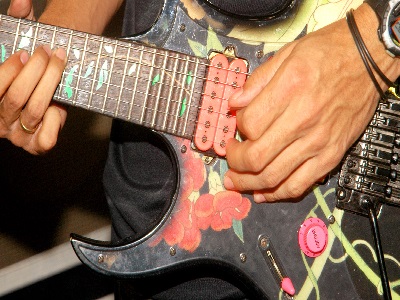Arpeggios: The Art of Broken Chords
 What use is anything worth if it’s broken? What purpose would it serve to take something whole and divide it into no more than a skeletal image of itself?
What use is anything worth if it’s broken? What purpose would it serve to take something whole and divide it into no more than a skeletal image of itself?
The answer to both of these questions is one simple word, a prominent concept in musical theory; it is something called an arpeggio.
Arpeggios are, as the title insinuates, chords that are broken. But don’t take the concept literally; you don’t exactly take a chord and smash it to bits on a table to create an arpeggio.
When a chord is played, all of the notes are struck simultaneously, ringing out as one voice. This is a concept known as harmony. When you take that same chord and strike the notes separately, one at a time, it becomes melodic. It also becomes an arpeggio. An arpeggio is a fancy term for a chord played note by note, either ascending or descending, in succession.
Now that you understand what an arpeggio is, naturally you may begin wondering what good there is in playing a chord one note at a time. Once you know a chord, there is no use in further studying it, right?
Wrong.
Arpeggios are used in a variety of musical styles. From flamenco to jazz, heavy metal to progressive rock, arpeggios have become somewhat of a staple in music. They can add flair to guitar solos when combined with sweep picking (a concept we will discuss further in future articles), or extra classiness to your acoustic pieces.
Constructing A Simple Arpeggio
Let’s make an arpeggio using C major, a scale whose key signature contains no accidentals (flats or sharps). If we make a first inversion, root position triad, our results would be C as our root, E as our third, and G as our fifth. Instead of playing all three notes in unison, to make this chord an arpeggio we would play the chord either starting on C and ending on G, or the opposite, starting on G and ending on C. As each note rings out separately, they create a melody. Thus, you have played your first arpeggio.
Now that you have the knowledge of how to create basic arpeggios, you can use them to spruce up your music. Instead of strumming chords constantly, try playing them note by note. The contrast created between strumming the chord and playing it note by note will create an interesting dynamic. Arpeggios, the limitless wonders.
Any Chord Can Be Turned Into An Arpeggio.
Jazz guitarists frequently use arpeggios when improvising along a scale. Try experimenting with adding notes, whether they are octaves or notes in similar scales. Adding these notes can change the quality of an arpeggio, giving it new and exciting qualities.
For example, let’s use our C major arpeggio. If we start on C, move on to E, then end on G, we can move three notes upwards from G and end on a higher octave of C. That one extra note, a simple octave, completely changed the quality of our arpeggio, making it far more compelling.
As with any guitar technique, the possibilities for arpeggio construction extend as far as your mind is able to reach. Proper implementation of arpeggios can make your music both engrossing and unique.
I guess it’s safe to say that broken chords aren’t so bad, huh?
Here’s a very interesting video on how to apply arpeggios to your playing and how you can get creative with adding them into any particular song…







Leave A Comment